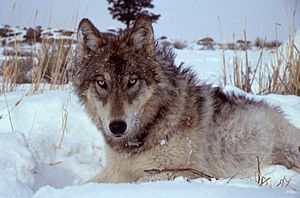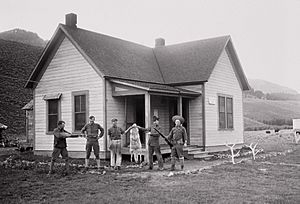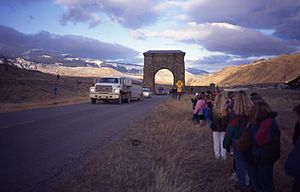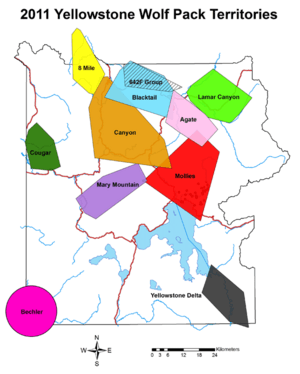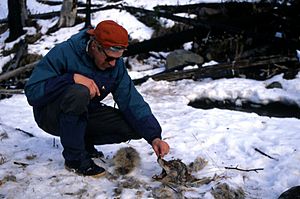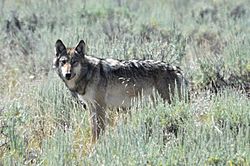History of wolves in Yellowstone facts for kids
The history of wolves in Yellowstone National Park is a fascinating story. It tells how gray wolves, also known as Canis lupus, disappeared from the park, were absent for many years, and then were brought back. This project, called wolf reintroduction, was a big deal and caused a lot of discussion.
When Yellowstone National Park was created in 1872, wolf numbers were already going down in nearby states like Montana, Wyoming, and Idaho. The park's creation didn't immediately protect wolves. In fact, government programs in the early 1900s aimed to remove wolves from Yellowstone. The last known wolves were killed in the park in 1926. After that, wolves were gone from Yellowstone for a long time.
However, starting in the 1940s, people began to push for wolves to be brought back. This idea gained strength, and in 1995, gray wolves were finally reintroduced into Yellowstone. They were first released in an area called the Lamar Valley.
Contents
Wolves Disappear (1872–1926)
When Yellowstone National Park started in 1872, there were no laws to protect wildlife. In the early years, hunters and visitors could kill almost any animal they found. Wolves were especially targeted because many people saw them as harmful predators. They were being removed from many parts of North America.
In 1883, new rules were made to stop hunting most animals in the park. But these rules didn't protect wolves, coyotes, bears, or mountain lions.
The U.S. Army took over managing the park in 1890. The first military superintendent, Captain Moose Harris, allowed public hunting. The Army didn't start killing wolves officially until 1914.
In 1907, a government agency began a program called Animal Damage Control. This program aimed to control predators. In just one year, this program killed 1,800 wolves and 23,000 coyotes in U.S. National Forests. When the National Park Service was created in 1916, it was allowed to destroy animals that were seen as harmful to the parks.
Most experts agree that wild wolf packs were gone from Yellowstone National Park by 1926. The National Park Service continued its predator control policies until 1933. However, studies later showed that there were hundreds of possible wolf sightings in the park between 1927 and 1977. More reliable sightings happened before 1995, but these were usually single wolves or pairs just passing through.
How Many Wolves Were Killed?
Before the National Park Service took over in 1916, the U.S. Army killed 14 wolves. Most of these were killed in 1914 and 1915.
A wildlife biologist named Adolph Murie reported how many wolves park managers killed between 1915 and 1935:
| Year | Number killed |
|---|---|
| 1915 | 7 |
| 1916 | 14 |
| 1917 | 4 |
| 1918 | 36 |
| 1919 | 6 |
| 1920 | 28 |
| 1921 | 12 |
| 1922 | 24 |
| 1923 | 8 |
| 1924–1935 | 0 |
Later research confirmed that the last official killing of wolves in the park happened in 1926. Two wolf pups found near Soda Butte Creek were killed by park rangers.
Wolves Are Absent (1926–1995)
Changes in the Ecosystem
Once the wolves were gone, the number of elk in Yellowstone started to grow a lot. Over the next few years, the park's environment began to suffer. Scientists visiting in 1929 and 1933 said the land was in "deplorable conditions."
Many biologists worried about the land eroding and plants dying. The large elk population ate too many trees like aspen and cottonwood. The park service tried to control the elk by trapping and moving them, and even by killing them. These efforts continued for over 30 years. While they stopped the land from getting worse, they didn't make it better.
Some people suggested bringing wolves back to help control the elk. But Yellowstone's managers were not keen on this idea, especially after working so hard to remove them. Elk control continued into the 1960s. However, local hunters complained that there were too few elk, and politicians threatened to stop funding the park. So, killing elk was stopped.
When elk populations rose again, the quality of the land decreased, affecting many other animals. Without wolves, the number of coyotes grew a lot. This negatively impacted animals like pronghorn antelope. But it was the huge elk populations that caused the biggest changes to Yellowstone's ecosystem when wolves were absent.
Efforts to Bring Wolves Back
The idea of bringing wolves back to Yellowstone grew from many scientific studies. In 1940, Adolph Murie's work on coyotes and wolves helped build a scientific reason for wolf conservation.
In 1944, a famous wildlife biologist named A. Starker Leopold, who used to support predator control, said that wolves should be allowed to live in large national parks like Yellowstone. He wondered why wolves removed from livestock areas weren't used to restock Yellowstone.
By the 1960s, people's understanding of ecosystems was changing. They started to see wolves and other large predators differently. This included the idea of a keystone species, which is a species that has a huge impact on its ecosystem. In the early 1960s, Canadian biologist Douglas Pimlott called for wolves to be brought back to the northern Rockies.
In 1970, American wolf expert David Mech published an important study called The Wolf. This book helped people understand wolves and their role in nature. In 1978, wildlife biologist John Weaver recommended bringing wolves back to Yellowstone.
The gray wolf was listed as an endangered species in 1967. But it wasn't until the Endangered Species Act of 1973 was passed that there was a legal way to reintroduce wolves to Yellowstone. This act required the U.S. Fish and Wildlife Service to create plans to help endangered species recover.
A plan to recover the Northern Rocky Mountain wolf was published in 1987. It aimed to remove the wolf from the endangered list by having at least 10 breeding pairs of wolves in three different areas for three years in a row.
In 1991, Congress told the U.S. Fish and Wildlife Service to study the idea of reintroducing wolves to Yellowstone and parts of Idaho. The study was finished in 1994. It looked at five different ways to bring wolves back.
The chosen plan was to reintroduce wolves as "nonessential experimental populations." This meant that while the wolves were protected, there would be special rules to help address local concerns, especially outside the park.
Not everyone agreed with the plan. Some environmental groups thought the wolves wouldn't be protected enough. Some farming groups argued that the wrong type of wolf was being used. However, these issues were resolved, and in January 1995, the reintroduction of wolves into Yellowstone began.
Wolves Return (1995–Present)
First Releases (1995–1996)
In January 1995, wildlife officials from the U.S. and Canada caught 14 wolves from packs in Alberta, Canada. These wolves arrived in Yellowstone in two groups. They were placed in special pens in the Lamar Valley. In March 1995, the pens were opened, and all 14 wolves were released into the park.
In January 1996, 17 more wolves from Canada arrived and were released in April 1996. These were the last wolves released. Officials believed that the wolves would reproduce and survive well enough on their own.
Annual Wolf Status
When wolf populations go down, it's usually because of fights between wolves, lack of food, diseases like mange or canine distemper, or legal hunting outside the park. In one case in 2009, park officials had to remove a wolf that had become too used to humans.
*From 1995-1999, the data includes wolves in the wider Greater Yellowstone Ecosystem. Since 2000, monitoring has focused on packs inside the park. Wolves have spread to surrounding areas. In 2002, the park reported 272 wolves in the Greater Yellowstone Area.
| Annual status of Wolves in Yellowstone (as of December) | ||||
|---|---|---|---|---|
| Year | Total number of packs | Total number of wolves | Number of pups surviving | |
| style="text-align:center;"|3 | 21 | 9 | ||
| style="text-align:center;"|9 | 51 | 14 | ||
| style="text-align:center;"|9 | 86 | 49 | ||
| style="text-align:center;"|11 | 112 | 36 | ||
| style="text-align:center;"|11 | 118 | 38 | ||
| 2000 | 8 | 119 | 55-60 | |
| 2001 | 10 | 132 | 43 | |
| 2002 | 14 | 148 | 58 | |
| 2003 | 13–14 | 174 | 59 | |
| 2004 | 16 | 171 | 59 | |
| 2005 | 13 | 118 | 22 | |
| 2006 | 13 | 136 | 60 | |
| 2007 | 11 | 171 | 64 | |
| 2008 | 12 | 124 | 22 | |
| 2009 | 14 | 96 | 23 | |
| 2010 | 11 | 97 | 38 | |
| 2011 | 10 | 98 | 34 | |
| 2012 | 10 | 83 | 20 | |
| 2013 | 10 | 95 | 41 | |
| 2014 | 11 | 104 | 40 | |
| 2015 | 10 | 98 | 35 | |
| 2016 | 11 | 108 | 36 | |
| 2017 | 11 | 97 | 21 | |
Ecological Impacts of Wolf Reintroduction
Scientists have been studying how the return of wolves has changed Yellowstone's ecosystem since 1995.
As the wolf population grew, the number of elk, which are their main food, went down. Before the wolves returned, it was thought that each wolf would kill about 12 elk per year. But it turned out wolves kill about 22 elk per wolf each year. This drop in elk numbers has led to changes in plants, especially willows, cottonwoods, and aspens.
Even though wolves directly cause elk numbers to drop, research shows that elk behavior has also changed a lot. The constant presence of wolves has pushed elk into less safe areas. This has increased their stress, lowered their nutrition, and reduced their birth rate.
Wolves also became major predators of coyotes after they were reintroduced. The local coyote population in Yellowstone changed dramatically. Before wolves, Yellowstone had one of the largest and most stable coyote populations. Two years after wolves returned, the coyote population was cut in half. About 16% of coyotes with tracking collars were killed by wolves.
Yellowstone coyotes had to move their territories from open meadows to steeper areas. Carcasses in the open no longer attract coyotes. If a coyote is chased on flat land, it's often killed. They feel safer on steep ground, where they can lead a wolf downhill and then run uphill, gaining a lead because wolves are heavier.
Coyotes naturally keep fox numbers down. So, fewer coyotes led to more foxes. This change affects the survival of animals that coyotes usually eat, like hares and young deer. It also impacts small rodents and ground-nesting birds that foxes hunt. These changes can affect what plants get eaten, changing the balance of plant communities and impacting the entire food chain.
The return of wolves has also led to a big increase in the park's beaver population. In 2001, there was only one beaver colony in Yellowstone. By 2011, there were nine! Wolves seem to have made elk graze more widely, which means they eat fewer willows. Willows are important for beavers to survive the winter.
More beavers in the ecosystem have big effects on the water system. Beaver dams help control water flow, store water, and create cool, shaded water for fish. Beaver dams also stop erosion and create new pond and marsh habitats for animals like moose, otters, mink, wading birds, waterfowl, fish, and amphibians.
Similarly, after wolves returned, their hunting of elk helped Yellowstone's grizzly bear population. There was a big increase in berries, which are an important food source for grizzly bears.
Wolf kills provide food for many other animals, including ravens, wolverines, bald eagles, golden eagles, black bears, jays, magpies, martens, and coyotes.
Wolf packs also often take over kills made by cougars. This has pushed cougars back to their usual mountain territories, away from the valley hunting grounds.
The way the return of a top predator like the wolf affects many other plants and animals in an ecosystem is called a trophic cascade.
Wolves and the Endangered Species List (2009)
Because gray wolf populations in Montana, Wyoming, and Idaho had recovered enough, the U.S. Fish and Wildlife Service changed their status in 2008. They were no longer considered "Endangered" but "Experimental Population-Non Essential."
Wolves in Yellowstone and the surrounding areas are part of this population. Because of this change, Idaho and Montana allowed hunting seasons for wolves as part of their state management plans. Some environmental groups disagreed with this and tried to stop the hunts. But despite legal challenges, the wolf hunts in Montana started in September 2009.
Even though wolves inside the park were still fully protected, wolves that went outside the park into Idaho or Montana could now be legally hunted. During these hunts, some wolves known to spend time in the northeast part of the park were killed by hunters in Montana.
Reactions to Wolf Reintroduction
Hunting Opportunities
From 2000 to 2004, Montana reduced the number of elk hunting permits. This was because the elk population had decreased. At first, the effects of wolves on elk were not clear. But from the winter of 1995 to the winter of 2004, the number of elk dropped significantly. This happened as the number of wolves increased. Other factors like bears, more human hunting, harsh winters, and droughts also played a role.
Since 2000, wolves have caused 75% of known elk deaths due to predators. Human hunting caused 8-30% of known elk deaths during the same time. Elk make up to 92% of what wolves eat in Yellowstone during winter. Wolves in Yellowstone kill about 22 hoofed animals per wolf each year. This is higher than the 12 animals per wolf that was predicted.
Wolf Subspecies
Historically, the wolves native to Yellowstone were called C. l. irremotus. When it was time to reintroduce wolves, there was a discussion about which type of wolf to use. Some argued that the original Yellowstone wolves were more like C. l. nubilus, a type found in Minnesota. They said the Canadian wolves chosen for reintroduction were C. l. occidentalis, which are larger.
However, others argued that wolves don't have much genetic difference and that the original Yellowstone wolves were already gone. Doug Smith, a wolf expert, stated that the size difference between the introduced wolves and the original wolves was only about 6-7 percent. He also pointed out that Minnesota wolves had no experience with elk and bison and were not used to mountain areas. Yellowstone National Park officials deny that the "wrong wolf" was introduced.


